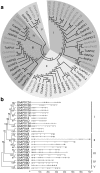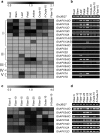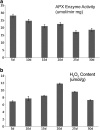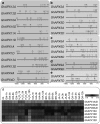Genome-wide investigation and expression profiling of APX gene family in Gossypium hirsutum provide new insights in redox homeostasis maintenance during different fiber development stages
- PMID: 29307114
- PMCID: PMC5948307
- DOI: 10.1007/s00438-017-1413-2
Genome-wide investigation and expression profiling of APX gene family in Gossypium hirsutum provide new insights in redox homeostasis maintenance during different fiber development stages
Abstract
Ascorbate peroxidase (APX) is a member of heme-containing peroxidases which catalyze the H2O2-dependent oxidation of a wide range of substrates in plants and animals. As is known, H2O2 acts as a signaling molecule in the regulation of fiber development. Our previous work reported that ascorbate peroxidase 1 (GhAPX1) was important for cotton fiber elongation. However, knowledge about APX gene family members and their evolutionary and functional characteristics in cotton is limited. Here, we report 26 GhAPX genes by genome-wide investigation of tetraploid cotton Gossypium hirsutum. Phylogenetic and gene structure analyses classified these APX members into five clades and syntenic analysis suggested two duplication events. Expression profiling of the 26 APXs revealed that ten members are expressed in cotton fibers. Notably, GhAPX10A, GhAPX10D, GhAPX12A, and GhAPX12D showed high expression levels in 30-day fiber, while GhAPX1A/D, GhAPX3A/D, and GhAPX6A/D showed very low expression levels. The enzyme activity and H2O2 content assays revealed that cotton fiber kept high enzyme activity and the lowest H2O2 level in 30-day fibers, indicating that other than GhAPX1, the newly reported APX members are responsible for the reactive oxygen species homeostasis in the cotton fiber maturation stages. Expression profiling of ten fiber-expressed APXs after phytohormone treatments revealed their regulation patterns by different stimuli, suggesting that GhAPX1, GhAPX12A, and GhAPX12D are responsible to most phytohormone treatments. Our data provided evolutionary and functional information of GhAPX gene family members and revealed that different members are responsible to redox homeostasis during different cotton fiber development stages.
Keywords: Ascorbate peroxidase; Cotton fiber; Expression profiling; Gossypium hirsutum; Redox homeostasis.
Conflict of interest statement
Conflict of interest
The authors declare that they have no conflict of interest.
Ethical approval
This article does not contain any studies with human participants or animals performed by any of the authors.
Figures







Similar articles
-
Fibre elongation requires normal redox homeostasis modulated by cytosolic ascorbate peroxidase in cotton (Gossypium hirsutum).J Exp Bot. 2016 May;67(11):3289-301. doi: 10.1093/jxb/erw146. Epub 2016 Apr 17. J Exp Bot. 2016. PMID: 27091877 Free PMC article.
-
A cotton ascorbate peroxidase is involved in hydrogen peroxide homeostasis during fibre cell development.New Phytol. 2007;175(3):462-471. doi: 10.1111/j.1469-8137.2007.02120.x. New Phytol. 2007. PMID: 17635221
-
Cotton cytosolic pyruvate kinase GhPK6 participates in fast fiber elongation regulation in a ROS-mediated manner.Planta. 2016 Oct;244(4):915-26. doi: 10.1007/s00425-016-2557-8. Epub 2016 Jun 17. Planta. 2016. PMID: 27316434
-
[Expression regulation of plant ascorbate peroxidase and its tolerance to abiotic stresses].Yi Chuan. 2013 Jan;35(1):45-54. doi: 10.3724/sp.j.1005.2013.00045. Yi Chuan. 2013. PMID: 23357264 Review. Chinese.
-
Genome-wide analysis of the serine carboxypeptidase-like protein family reveals Ga09G1039 is involved in fiber elongation in cotton.Plant Physiol Biochem. 2023 Aug;201:107759. doi: 10.1016/j.plaphy.2023.107759. Epub 2023 May 12. Plant Physiol Biochem. 2023. PMID: 37321040 Review.
Cited by
-
Comparative analysis of synteny and functional divergence of APX genes in Fragaria vesca and Fragaria×ananassa.BMC Plant Biol. 2025 May 2;25(1):572. doi: 10.1186/s12870-025-06631-6. BMC Plant Biol. 2025. PMID: 40312667 Free PMC article.
-
Ascorbic acid modulation by ABI4 transcriptional repression of VTC2 in the salt tolerance of Arabidopsis.BMC Plant Biol. 2021 Feb 24;21(1):112. doi: 10.1186/s12870-021-02882-1. BMC Plant Biol. 2021. PMID: 33627094 Free PMC article.
-
Comparative Proteomic Analysis Reveals the Ascorbate Peroxidase-Mediated Plant Resistance to Verticillium dahliae in Gossypium barbadense.Front Plant Sci. 2022 May 19;13:877146. doi: 10.3389/fpls.2022.877146. eCollection 2022. Front Plant Sci. 2022. PMID: 35665163 Free PMC article.
-
The Drought Tolerance Function and Tanscriptional Regulation of GhAPX7 in Gossypium hirsutum.Plants (Basel). 2024 Jul 24;13(15):2032. doi: 10.3390/plants13152032. Plants (Basel). 2024. PMID: 39124150 Free PMC article.
-
Effect of drought acclimation on antioxidant system and polyphenolic content of Foxtail Millet (Setaria italica L.).Physiol Mol Biol Plants. 2023 Oct;29(10):1577-1589. doi: 10.1007/s12298-023-01366-w. Epub 2023 Oct 5. Physiol Mol Biol Plants. 2023. PMID: 38076760 Free PMC article. Review.
References
-
- Alscher RG, Donahue JL, Cramer CL. Reactive oxygen species and antioxidants: relationships in green cells. Physiol Plant. 1997;100(2):224–233. doi: 10.1111/j.1399-3054.1997.tb04778.x. - DOI
MeSH terms
Substances
Grants and funding
LinkOut - more resources
Full Text Sources
Other Literature Sources
Research Materials
Miscellaneous

